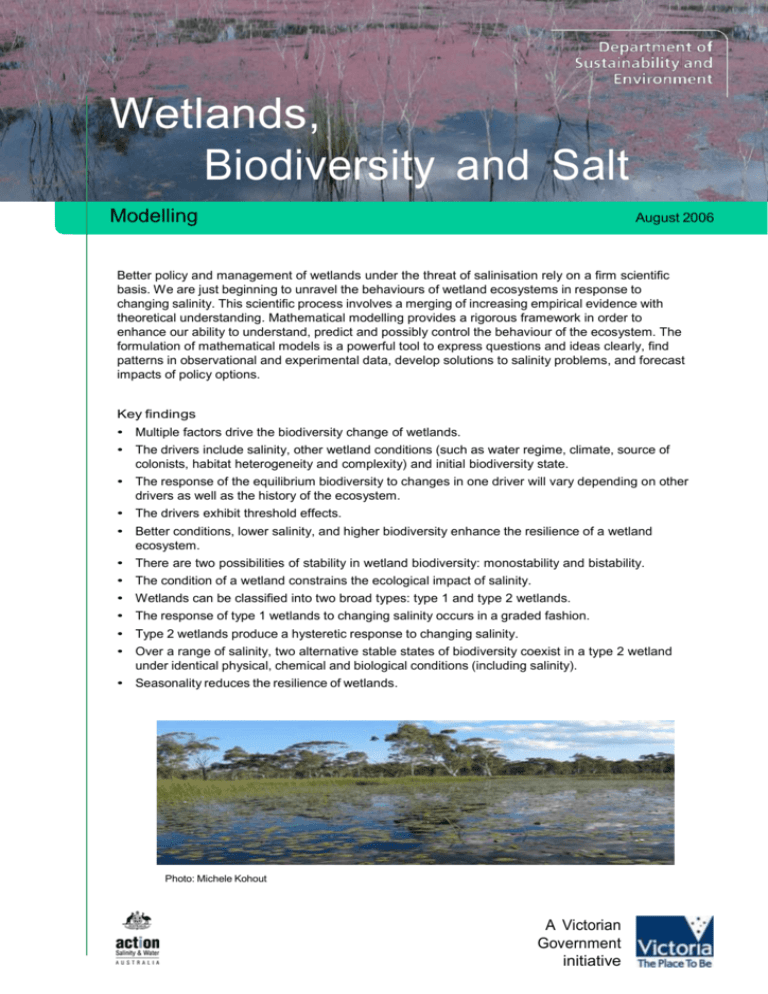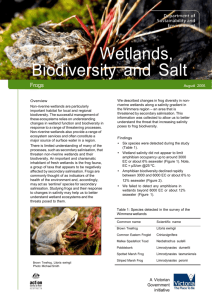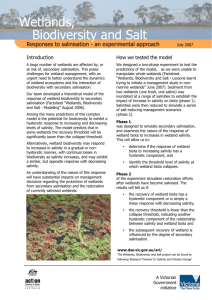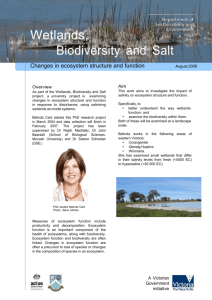Conceptual modelling (accessible version)
advertisement

Wetlands, Biodiversity and Salt Modelling August 2006 Better policy and management of wetlands under the threat of salinisation rely on a firm scientific basis. We are just beginning to unravel the behaviours of wetland ecosystems in response to changing salinity. This scientific process involves a merging of increasing empirical evidence with theoretical understanding. Mathematical modelling provides a rigorous framework in order to enhance our ability to understand, predict and possibly control the behaviour of the ecosystem. The formulation of mathematical models is a powerful tool to express questions and ideas clearly, find patterns in observational and experimental data, develop solutions to salinity problems, and forecast impacts of policy options. Key findings • Multiple factors drive the biodiversity change of wetlands. • The drivers include salinity, other wetland conditions (such as water regime, climate, source of colonists, habitat heterogeneity and complexity) and initial biodiversity state. • The response of the equilibrium biodiversity to changes in one driver will vary depending on other drivers as well as the history of the ecosystem. • The drivers exhibit threshold effects. • Better conditions, lower salinity, and higher biodiversity enhance the resilience of a wetland ecosystem. • There are two possibilities of stability in wetland biodiversity: monostability and bistability. • The condition of a wetland constrains the ecological impact of salinity. • Wetlands can be classified into two broad types: type 1 and type 2 wetlands. • The response of type 1 wetlands to changing salinity occurs in a graded fashion. • Type 2 wetlands produce a hysteretic response to changing salinity. • Over a range of salinity, two alternative stable states of biodiversity coexist in a type 2 wetland under identical physical, chemical and biological conditions (including salinity). • Seasonality reduces the resilience of wetlands. Photo: Michele Kohout A Victorian Government initiative Biodiversity The predicted relationship between wetland biodiversity and salinity for type 1 wetlands. Salinity Biodiversity The predicted relationship between wetland biodiversity and salinity for type 2 wetlands. Salinity Possible implications for protection and enhancement • Avoid crossing thresholds. • Consider the impact of the wetting and drying cycle in risk assessment. • Prioritise assets and investment, taking into account thresholds and seasonality. • Invest to improve resilience. Possible implications for restoration • Engineer crossing thresholds. • Maintain biodiversity in the larger landscape for recruitment. • Strong seasonality facilitates recovery. • Investigations of the difference between type 1 and type 2 wetlands may lead to more targeted intervention. Published by the Victorian Government Department of Sustainability and Environment Melbourne, August 2006 © The State of Victoria Department of Sustainability and Environment 2006 This publication is copyright. No part may be reproduced by any process except in accordance with the provisions of the Copyright Act 1968. Authorised by the Victorian Government, 8 Nicholson Street, East Melbourne. ISBN 1 74152 633 7 For more information contact the DSE Customer Service Centre 136 186 or Dr Michael Smith on (03) 9450 8612 or michael.smith@dse.vic.gov.au, Arthur Rylah Institute, Department of Sustainability and Environment, PO Box 137, Heidelberg 3084. This publication may be of assistance to you but the State of Victoria and its employees do not guarantee that the publication is without flaw of any kind or is wholly appropriate for your particular purposes and therefore disclaims all liability for any error, loss or other consequence which may arise from you relying on any information in this publication. www.dse.vic.gov.au/ari/ the Wetlands, Biodiversity and Salt project can be found by following ‘Research Themes’ to ‘Salinity and Climate change’




